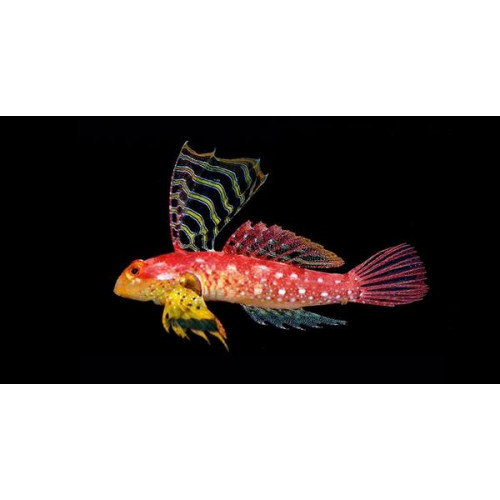Species Name : Synchiropus Sycorax
Care Level : Difficult
Temperament : Peaceful
Color : Red, White, Yellow
Diet : Carnivore
Reef Compatible : Yes
Water Conditions : sg 1.020-1.025, 72-78° F, dKH 8-12, pH 8.1-8.4
Max. Size : 3"
Origin : Philippines
Family : Callionymidae
Minimum Tank Size : 30 gallons
The Ruby Red Dragonet (Synchiropus Sycorax) is also referred to as Ruby Dragonet. This newly described Dragonet species originates from the Philippines. The Ruby Red Dragonet is beautifully colored and will be sure to add color and diversity to your aquarium.
The Ruby Red Dragonet has a ruby-red body with mottled white spots and intensely yellow fins outlined with stark black. They are very peaceful and can be housed with other peaceful fish in a reef tank setting, but may become territorial towards other blennies, gobies or dartfish in smaller tanks.
It prefers a reef aquarium of 30 gallons or larger with lots of live rock to hide in and graze from. The substrate should be live sand and the aquarium should have docile inhabitants. Whichever size tank you choose, ensure you have a tight-fitting cover. All of the members of the dragonet family have superb jumping skills. More than one of its species may be kept, and it is best to introduce them all to the tank at the same time. The ratio should be 2 or 3 females per male. A 55 gallon or larger aquarium is required if more than one male is to be kept. The male will use his elaborate dorsal fin to display to the females during courtship rituals. If more than one male is present, the rivals will both use their dorsal fins as a show of dominance.
Dragonets spend their time cautiously prowling the floor of the reef. They have small protruding mouths they use to feed specifically on live copepods, amphipods, and other micro fauna amongst the sand, coral rubble, and seagrass beds.
In aquariums, they have the unfortunate reputation of being difficult to keep because of the tendency not to accept prepared aquarium foods and competition for food by other more aggressive tank mates. This is a very real and serious threat to these fish in aquariums. They lack any sort of aggressive feeding behavior which often results in a slow and gradual demise in a fish tank because they cannot get enough food. Thankfully, success is possible with just a little knowledge and understanding of the dragonet feeding behaviors.
Diet should include a variety of mysis shrimp and vitamin enriched brine shrimp as well as a steady supply of amphipods, copepods, spirulina, marine algae, seaweed and algae based foods 2-3 times daily. They are slow-moving, deliberate feeders and should not have to compete for their food.
-
There are no reviews for this product.
-
No questions yet
Tags: Fishes


